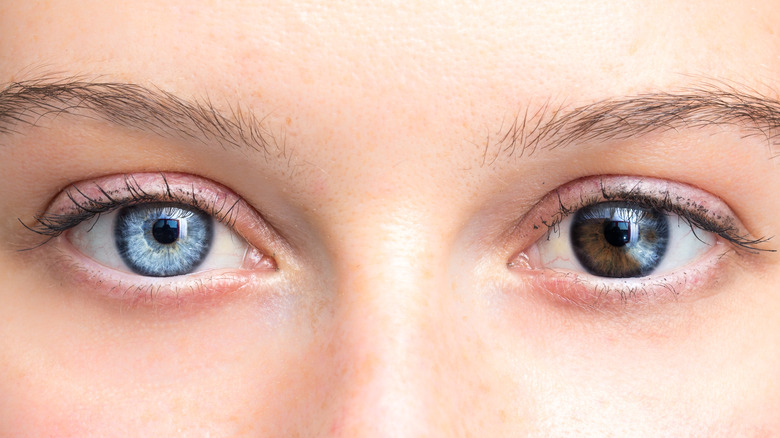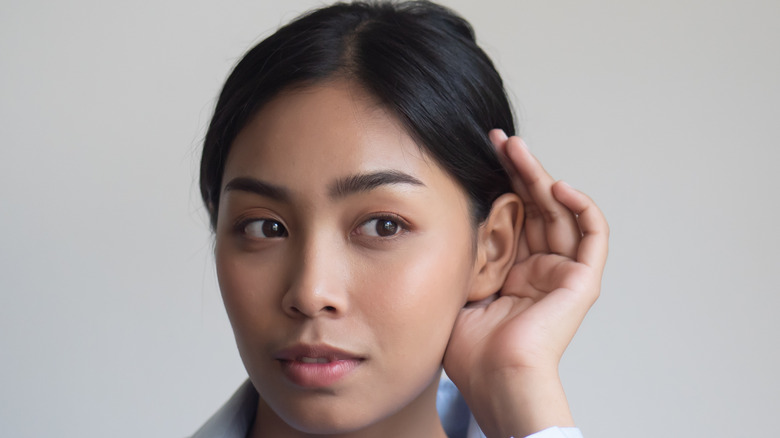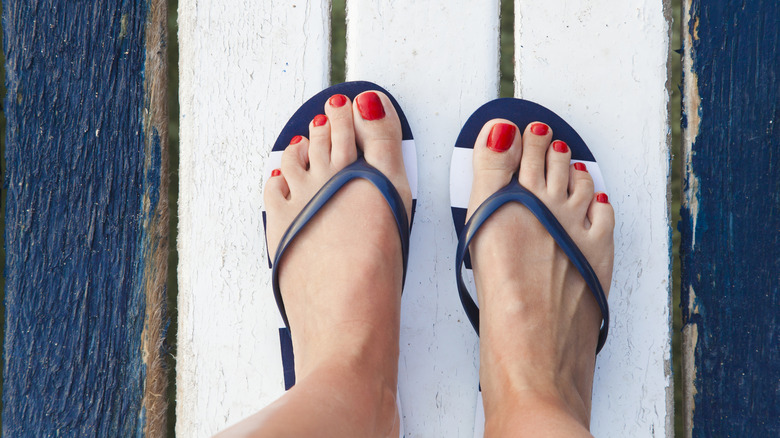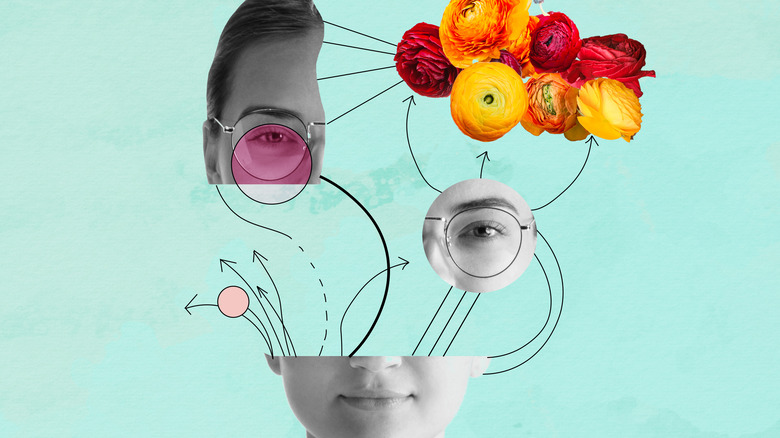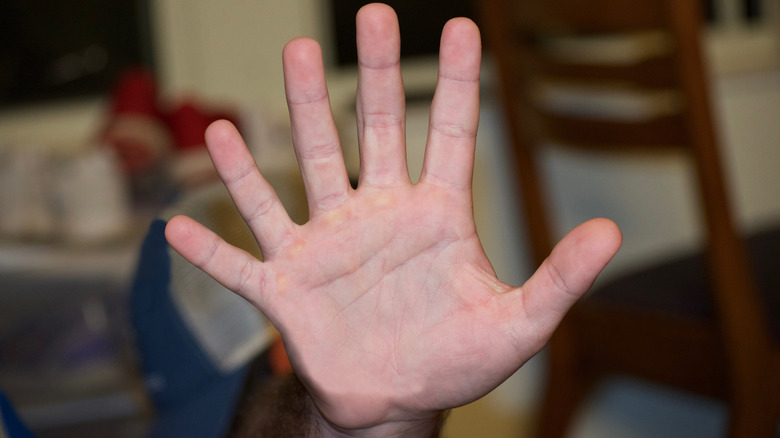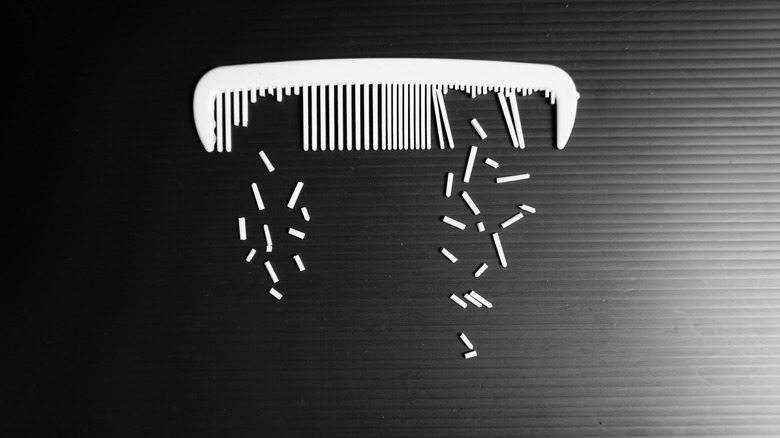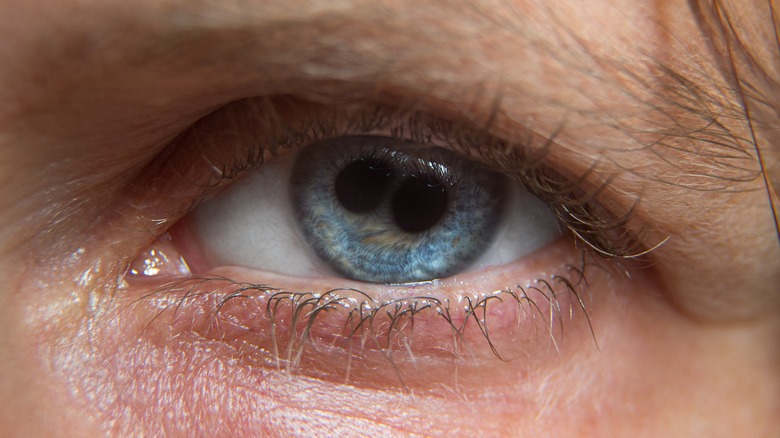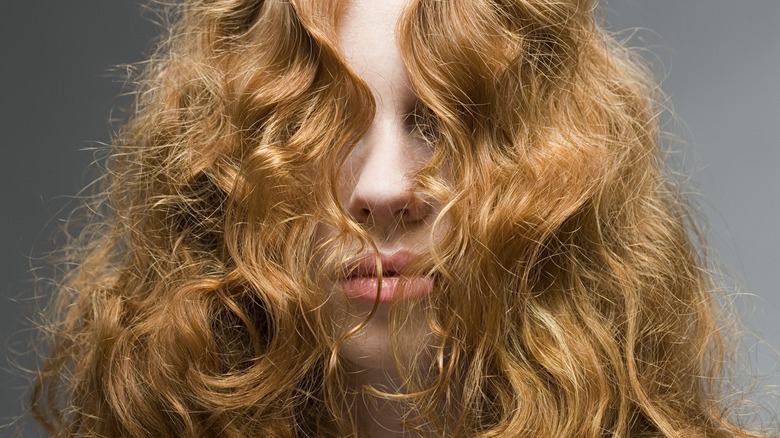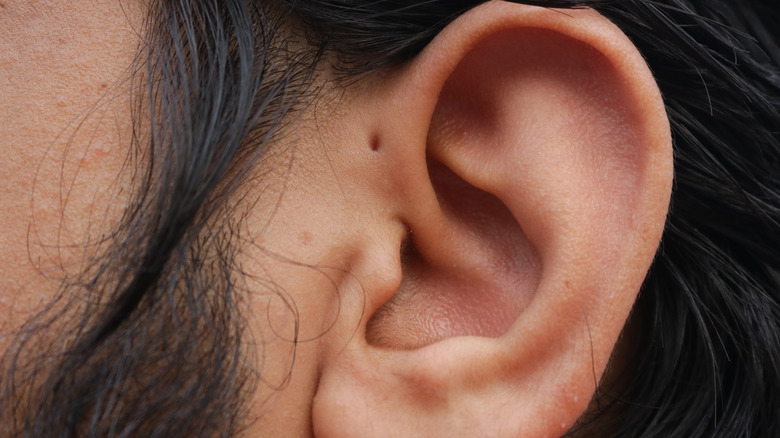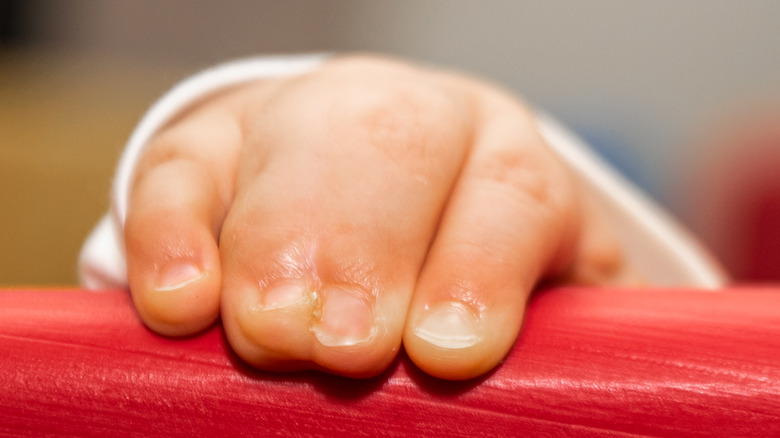Most People Don't Have These Rare Body Features
To quote one Cosmo Kramer, "Mother nature's a maaad scientist!" And we only have to look at ourselves to see this. Consider, for example, the seemingly infinite varieties of the human form. Human facial features have more variety than any other species on earth (via The Human Evolution Blog). One artist documented more than 4,000 different skin tones among people she photographed (via Artnet News). Average adult human height across the world, measured in 2014, ranged from 160 centimeters (5 feet 3 inches) to 182 centimeters (5 feet 11.5 inches) for men and 149 centimeters (4 feet 10.7 inches) to 169 centimeters (5 feet 6.5 inches) for women (via Our World in Data). And eye color has so many variations that your eyes are as unique as your fingerprints (via American Academy of Ophthalmology).
But even among the wide range of possibilities, there are some traits which are rarer than others, some so rare you've probably never heard of them. You may have one or more of these characteristics yourself, in which case our hat's off to you: All of us are unique, but you're more unique than most.
Some people's eyes don't match
When somebody's eyes seem to be two different colors, it could be they're wearing novelty contact lenses. (Which, btw, the FDA says can damage your eyes if you don't get a prescription for them). Or it could be that their eyes really do have different hues, a condition called heterochromia (via the Cleveland Clinic).
Eye color describes the iris, the ring of muscle that surrounds the pupil and lets light into the eye. The color of the iris is determined by the pigment melanin; more melanin equals a darker eye color. The amount of melanin in the iris is determined by a combination of genes. Most people have the same melanin content in both eyes, and so their eye colors match. But a genetic mutation can cause one eye to vary from the other. Heterochromia can cause a color variation within one iris, or partial heterochromia, as a well as a difference between eyes, or complete heterochromia (via the American Academy of Ophthalmology). When it occurs at birth, heterochromia usually doesn't come with other symptoms or any health issues, though an exam is warranted to rule out underlying problems. Heterochromia can also occur later in life, and as with any change in eye appearance, this is reason to see an ophthalmologist.
Your tongue might have extra taste buds
Maybe there's no accounting for taste. But we do know that about 25% of the population has a higher density of taste buds on their tongue than the average mortal (via Harvard School of Public Health). Also known as "supertasters," they're particularly sensitive to bitter flavors; in lab tests, they're repulsed by the bitterness of certain chemicals that other people can't taste at all. (Another 25% of people are "non-tasters," with weaker-than-normal tasting ability.)
Being a supertaster seems to be something of a mixed blessing. Because of their sensitivity to flavor, they tend to consume fewer high-sugar, high-fat foods, which is a plus for health. They also tend to dislike alcohol and tobacco. On the other hand, their sensitivity to bitterness can cause supertasters to avoid healthy vegetables, which may have a bitter taste. They don't like spicy foods — their extra taste buds include extra pain sensors — and tend to use more salt (it masks bitterness). For their part, non-tasters tend to eat more high-fat, sugary food, perhaps because they need more of it to enjoy the taste. So this is a case where it seems best to be of average ability.
Being truly even-handed is a rare thing
It's a right-handed world we live in: About 90% of people are right-handed, according to the American Psychological Association (APA). Most of the remaining 10% are left-handed. The truly ambidextrous — those who can perform all tasks equally well with either hand — make up the rarest "handedness" category of all, numbering just 1%.
Why do most of us have a dominant hand? The answer's unclear, but seems related to the way our brain is divided into two hemispheres. Keeping specific functions on one side or other means information doesn't have to cross over, according to the APA. Our genes influence which hand we favor, but other factors — including just random chance — also play a role (via Medline Plus). So two left-handed parents can have a right-handed child, and identical twins can have opposite hand preferences.
While the ability to use both hands equally well for everything may seem, er, handy, it's possible that being ambidextrous comes with drawbacks. One study found that ambidextrous kids do worse on tests of verbal, math, and reading skill than right- or left-handers (via Neuropsychologia), while other research showed that people without strong right- or left-handedness have greater declines in brain volume with age (via Brain and Behavior).
Perfect pitch: Use it or lose it.
Musical notes — an A-flat, an F-sharp, a middle C — aren't like colors. You know red or green when you see them, but hearing an isolated tone doesn't provide enough information for someone to identify where the pitch falls on the musical scale (via Psychology Today). Unless you happen to be among the 1 out 10,000 people born with the talent of absolute pitch. Also known as perfect pitch, this capability isn't only rare, it can be lost if it isn't paired with musical training at an early age. Usually this means music lessons starting at age 5; after age 9, successfully developing absolute pitch is unlikely. Some languages, like Mandarin or Vietnamese, use pitch to convey meaning, and people who are native speakers of such "tonal" languages are more likely to develop absolute pitch. Genetics may also play a role. And there is evidence that people can be trained to identify pitch, though their accuracy may not be as great as someone born with the ability (via Cognition).
For somebody with absolute pitch, an E-flat or A-natural is as recognizable as the voice of a friend. But that's not always a good thing; with perfect pitch, imperfection in music can be distracting. One study found that people with absolute pitch performed worse on a task if it was preceded by musical notation and a tone that didn't match (via Cortex).
Your long toe is NBD
OK, full disclosure: depending on where you live, having second toes that are longer than your big toes might not be rare at all. It might be the norm, or statistically close to it (via Health). But given how much attention was paid a few years back when Meghan Markle wore sandals which revealed — gasp — second toes that dared to go beyond the big toes, it's probably a good idea to put this trait in perspective.
The condition is known as "Morton's Toe," but it's not actually the case that the second toe is longer. According to The New York Times, it means that the bone in your foot that attaches to your big toe is on the short side, keeping toe no. 1 from taking point. Because this feature was often represented in Greek sculpture and art, it's also been called the "Greek toe," according to Healthline. A study found that it occurs among 62% of men and 32% of women in Greece (via Rheumatology). One ethnic group in Japan has a 90% frequency of Morton's Toe. Another study found that it occurred in 42% of a group of college students. Oh, and you know who has it? The freakin' Statue of Liberty. If you want to start a trend of calling it "Liberty's Toe," we won't stop you.
Some people need less sleep than the rest of us, don't hate them
We're in the midst of an epidemic of sleepiness, with more than a third of Americans not getting enough hours of sleep every night, according to the American Academy of Sleep Medicine. They recommend that all adults have at least seven hours of restful sleep per night. But a lucky few — about 5% of the general population — are able to wake up refreshed and rested with just four to six hours of sleep (via Scientific American). These "naturally short sleepers" seem to have mutations in genes that affect cells in the brain which regulate sleep, reports the National Institutes of Health. When researchers placed these genes into lab mice, the animals slept less than their unaltered peers.
Most people who try to get by with so little sleep will end up feeling sleep-deprived. But people with this genetic quirk seem to have a more efficient sleep cycle, enabling them to get the benefits of a good night's sleep in less time than the rest of us (via Scientific American). Understanding how this works could lead to better treatments for people with sleep problems, and maybe help us all get by with less sack time. "We know sleep is necessary for survival," study co-author and professor of neurology Ying-Hui Fu told Scientific American, adding, "We don't know anything about how it's regulated."
A lock of white hair stays with some people for life
As far as mutations go, this one is both hard to ignore and, generally, not very impactful beyond its effects on someone's appearance. Someone affected by "piebaldism" has a lack of melanocytes — the cells that produce hair pigment — in portions of their hair, usually above the forehead in the front of their hairline, producing a white forelock (via the National Library of Medicine). Sometimes the eyebrows or eyelashes are also affected, and the nearby skin may lack pigment as well. Usually this phenomenon is present at birth and lasts all throughout life. Piebaldism is different from vitiligo, which occurs when the immune system attacks melanocytes in the skin and produce unpigmented skin patches.
Piebaldism doesn't produce any ill effects, aside from affected skin being more vulnerable to sunburn and the development of skin cancers. But it may make some people self conscious about how they look. In such cases, skin grafts and hair dye are options for making a change (via the National Institutes of Health).
Synesthesia connects sensations in unexpected ways
What color is seven? What does a piano solo taste like? These questions may seem nonsensical to most of us. But a person with synesthesia might see a color when they read a particular word or number (via WebMD). Or they might experience a sensation of taste when hearing a certain sound, or hear a specific noise whenever they smell a particular scent. Synesthesia is a condition in which the stimulation of one sense automatically triggers another sensory experience. It occurs in 3-5% of the population, reports Psychology Today, and isn't a form of mental illness or disorder. Many people consider it a gift. Synesthesia can be experienced in a wide variety of ways: sounds can trigger colors, words can trigger tastes, a noise might cause a feeling of being touched. One of the most common forms is "grapheme-color synesthesia," in which particular numbers or letters become associated with colors.
A hallmark of synesthesia is that, for a person who has it, the experience is consistent. If the letter A is green for you, it will always be green. Brain imaging studies suggest that people with this trait have extra connections between parts of the brain that process different senses (WebMD).
Some people never forget a face, others never remember it
We've all had moments when where we're talking to someone who seems familiar, but we just can't place who they are. But a person with prosopagnosia is in a whole other category (via the National Institutes of Health). Sometimes called "face blindness," the term describes an extreme face-identifying deficit: those with the condition are unable to recognize familiar people, discern one unfamiliar face from another, or even recognize one's own face. Prosopagnosia can be an effect of disease, brain injury, or stroke, but some people are born with it (Department of Psychology, Bournemouth University). The condition likely involves a mutation or alteration affecting the area of the brain that coordinates facial perception and memory. Prosopagnosia may occur in 2-2.5% of the population, though a more precise way of diagnosing it is needed to get an accurate assessment. To experience a bit of what prosopagnosia is like, try identifying people by looking only at their hands.
At the other extreme are "super-recognizers," people who have an extraordinary ability to remember and identify faces that they've seen. First identified in a 2009 study, super-recognizers are as good at recognizing people as those with prosopagnosia are bad at it. A super-recognizer might recognize a face they saw just once, months or years ago, and this skill has led to them being considered for special roles in law enforcement and private security, reports The Guardian. Think you might be a super-recognizer? You can test your skill.
This tastes like soap, but not to everyone
Flavorful herb or vile weed? The spice cilantro isn't for everybody ... especially since some people have a gene that causes the plant to have a gross soap-like flavor for them. In a study published in 2012, researchers examined genetic data from about 30,000 people who answered questions about their attitude toward cilantro (their cilantrotude, if you will). They found that a particular gene variant tended to be found in people who described cilantro as tasting "soapy," or who disliked the taste of fresh cilantro (which, incidentally, are the leaves of coriander plants). The gene in question is involved in sensing the odor of a particular type of chemical found in the spice.
Other studies have linked the taste of cilantro to particular genes, according to a summary in the journal Nature. Genetic traits don't completely determine one's feelings toward cilantro, NPR reported, but they're probably part of the equation. Cilantro haters, or people who cook for them, can try to rehab the herb by crushing the plant before using it, which can break down the chemical compounds that trigger the soapy flavor (via Nature).
If nature gives you the finger, you might want to keep it
About one in 500 infants is born with an extra finger or toe, a condition called polydactyly (via Science Alert). Sometimes this occurs with no other anomalies, but it can also be part of a syndrome that produces other abnormalities (via the National Institutes of Health).
Extra digits can be removed surgically, but a study done a few years ago suggests that in some cases, having six fingers on a hand can be a benefit (via Nature Communications). (Having an extra or "supernumerary" finger occurs in 0.1% of the population). Researchers tested the manual dexterity of two people (a mom and her teenage son) who each had six fingers on both hands, recording their performance in a number of tasks, like manipulating and identifying objects while blindfolded, flipping pages in a book, folding a napkin, and rolling a towel. They also played a custom computer game using a keyboard. Compared to a small group of five-fingered people, the test subjects were able to perform more complex movements, and could do some tasks with one hand that normally require two. (You can see for yourself in this video via YouTube). MRI scans showed that the extra fingers had their own muscles, tendons, and nerves. "Extra fingers and toes are traditionally seen as a birth defect, so nobody has thought to study how useful they might really be," study author Etienne Burdet said in a press release.
A surprise party is a terrible idea for people with this trait
Ever heard of "Jumping Frenchmen of Maine?" No, that's not the name of a wry indie-pop band; you're thinking of Fountains of Wayne. JFM is actually a rare disorder in which someone who's startled has an uncontrollable, exaggerated response to being startled (via the National Association for Rare Disorders). Somebody with this condition might jump, scream, flail their arms, or throw things in reaction to an unexpected sound or a sudden poke. Stranger reactions include repeating another person's words or mimicking their movements, or automatically following simple commands like "run" or "jump." The symptoms begin after puberty but become less severe with age.
Not a lot is known about this very rare ailment. It was first identified among a group of French Canadian lumberjacks working in Maine camps, hence the name. But similar behavior has been documented in Louisiana, Malaysia, Siberia, India, and other parts of the world. It may be a genetic disorder, but cultural and environmental factors might also play a role in how the condition is expressed.
A super-sized spleen is a swimmer's secret weapon
It may not be one of the attention-hogging glamour organs like the heart or the brain, but your spleen is important in its own right. The avocado-sized organ, located just above your stomach, filters waste from your blood and generates cells and antibodies to protect you from infection (via the Cleveland Clinic). And in some populations, the spleen plays another significant role. A research team spent time studying an ethnic group called the Bajau, in Indonesia, who live on houseboats and survive on food collected by ocean diving (via University of Cambridge). Bajau divers spend 60% of their working time underwater, can dive to depths of 70 meters, and can hold their breath for extended periods — anecdotally, as long as 13 minutes. Because the spleen can release oxygenated blood cells into circulation during a dive, providing an oxygen boost, the researchers used an ultrasound device to measure spleen size in the Bajau and their land-dwelling neighbors. And the researchers found that the Bajau population had a 50% larger spleen size, on average. This was true across the whole population, not just those who were divers. Genetic analysis shows that the "sea nomads," as they've been called, have genes which produce higher levels of thyroid hormone, causing extra spleen growth.
When a bad hair days lasts for years
While some of us struggle with hair that's unruly, uncooperative, or maybe needs some styling to achieve the look we want, there are people with a rare disorder who literally cannot tame their lion-like mane. It's called "uncombable hair syndrome," the result of genetic mutations which affect proteins that form the hair shafts on the head — though luckily, nowhere else on the body (via the Genetics and Rare Diseases Information Center). Instead of the usual rounded cross section, people with this syndrome grow hair with a cross section that makes it impossible for the hair to be combed flat. The hair, which tends to be blond or straw-colored, stands out from the scalp in a "stuck a finger in an electric socket" kind of way. Fortunately this condition isn't usually associated with any health problems. It typically starts in childhood and usually improves, or even goes away, at the onset of puberty.
Having an extra pupil unfortunately doesn't help people with polycoria see better
People with polycoria have two pupils in at least one eye (per Healthline). Each pupil functions separately, but just like one pupil in an eye would. In other words, both pupils in an eye with polycoria expand and contract with light changes. Although you might think that having double the pupils would lead to even better vision, polycoria actually does the opposite. Not all people with this condition have significant vision problems, but they may have trouble with glare, blurriness, or double vision.
Polycoria is a super rare condition. Some people do look like they have polycoria but may actually have false polycoria, a condition that makes it look like a person has two separate pupils. Additionally, some people have a pupil that's bigger than the other, but this isn't true polycoria (per Vision Center). Unfortunately, the condition's rarity can make it difficult for vision professionals to determine the best treatment options for someone who needs vision correction for polycoria, but surgery is possible for some (per Healthline).
Red hair is stunning, but it's even rarer than you think
It's relatively well-known that red hair isn't as common as hair colors like brown or black. This is evident when you walk down a crowded road and rarely see a red head in sight. But did you know that only 1% to 2% of people in the world have red hair (per BMJ)? With nearly 8 billion people in the world, that number equates to about 160 million people. That sounds like a lot, until you consider that about 90% of people have brown hair (via MedlinePlus), accounting for about 7.2 billion people in the world's population.
Although rumors have run rampant saying that redheads will surely go extinct, possibly in the not-so-distant future, it's probably not going to happen. The genes that create red hair are the lowest in the pack in terms of recessive and dominant genes, so it's easy for other genes to take over. However, for those genes to phase out entirely, redheads would need to stop reproducing entirely (via National Geographic).
Some people have an extra hole in their ears
Look close or you might miss this one. Some people have an extra hole in their ears, but not one that's big enough to notice from a distance. Instead, these holes look like an ear piercing would, so you may not even think twice if you did see one on someone. They're called preauricular pits, which is a big name for such a small blemish. However, there's more below the surface of these holes that you don't see.
According to the Children's Hospital of Philadelphia, these tiny holes, which are formed at birth and result from not closing correctly during gestation, actually extend into the ear, essentially leaving an opening for bacteria to get into. Some people with preauricular pits can experience infections or dangerous abscesses. They could also cause cysts, which may not pose any immediate health problems, but could become painful. Others with these ear holes don't have any issues with them and, therefore, never require medical care to fix them.
Fewer than 50 people worldwide have golden blood
You've likely heard of common blood types A, B, and O. Types A and B can have the Rh factor, giving them a + or – sign to denote whether they have it or not. In simple terms, Rh is a protein that's an important factor in determining compatible blood types (per the American Red Cross).
However, there's a blood type that you've probably never heard of because it's extremely rare. It's known as Rhnull, nicknamed "golden blood" because only 43 people in the world have been known to have it (per Discovery). Why is it so special? According to the Journal of the Pakistan Medical Association, Rhnull lacks the Rh factor, which is already somewhat rare. But it also lacks other red blood antigens that are commonly found in most human blood. Fortunately, this ultra-rare blood type can come in handy for many. It's universal, so it can be used for blood transfusions for almost any blood type (via Discovery).
Forget talking and start communicating like animals
Humans communicate every day without thinking much of it. We gesture, make facial expressions, and talk to share our ideas and emotions with others. Animals don't necessarily have the same form of communication, but the ways in which they communicate are remarkable, nonetheless. In fact, some people have become so fascinated by echolocation — a method of communicating with sound that bats and whales use — that they've learned to do it themselves.
According to Scientific American, Daniel Kish, a man who was blind, learned to echolocate to help him determine where he is in his surroundings. Because he tapped into this skill, he was able to learn to ride a bike and travel without help from others. Researchers have also trained people to use this skill using sounds with different frequencies and intensities, but it certainly takes intense training to master. And some research has found that people who are better at visualizing images in their minds may also master echolocation more quickly.
These people can't visualize their thoughts
Take a moment to close your eyes and picture a place you love to be. Do that for just a few seconds, and you can probably see a relatively clear image of that place, like waves crashing on a beach or an open meadow filled with grass and flowers. However, people with aphantasia can't picture those images. Instead, they don't have any mental image pop up when they try to think of something. This phenomenon is expected to only affect up to 5% of the global population (per Aphantasia Network).
The challenging part of having aphantasia is that you may not know that your lack of visualization isn't typical. Therefore, you may not even know that something's off unless you discuss what you "see" with someone else. Fortunately, aphantasia does not necessarily cause any problems to people who have it. In fact, it's not considered a disability or health condition at all, but rather, a different way of thinking.
This rare hair feature has an ominous history
A widow's peak is pretty rare to find, especially because many people who have it try to cover it up in some way, like making a side part rather than parting their hair in the middle. This unique characteristic is simply just a hairline with a point in the middle, resembling an upside-down peak of a mountain. However, its name actually comes from the hats women used to wear when their husbands passed away, making them widows. They had pointed peaks that sat in the middle of the forehead, just like a hairline with a widow's peak (via WebMD).
Some superstitious people believe that a woman with a widow's peak is destined to be an early widow. Others see it as an undesirable characteristic, possibly because of its negative portrayal in entertainment. For example, Dracula has one of the most notable widow's peaks, making people immediately think of that character when they see one. However, widow's peaks are just the luck of the genetic draw, and they don't mean anything more or less than that. In fact, many of your favorite celebrities, like Leonardo DiCaprio and Marilyn Monroe, also sport this unique hair feature.
Have misaligned teeth? It might be a midline discrepancy
When most people smile, their two front teeth line up so that the space in between them aligns with the middle of their lips. People with midline discrepancies don't have this same feature, though. Instead, their front teeth are more asymmetrical, with the space between sitting more to the left or right of the midpoint of their lips. Some cases of midline discrepancy are so pronounced that one of a person's front teeth sit right in the middle of their mouth.
This condition can be disheartening for those who have it, causing confidence issues with their smiles. However, in most cases, it doesn't necessarily cause any dental or medical problems as long as a person cares for their teeth properly. Still, correction with braces could be warranted in some cases if a person's willing to pay to get the teeth alignment they want. For mild cases, invisible braces can even work.
Webbed fingers and toes sometimes run in families
When babies form during pregnancy, they start out very aquatic-like. After all, they're surrounded by fluid, so it makes sense that they'd have some adaptable features. When they first begin to sprout arms, legs, hands, feet, fingers, and toes, these appendages are quite underdeveloped.
At first, fingers and toes resemble the paddle-like feet of ducks and birds, which have what's known as webbed feet. In between each "finger" or "toe" is a stretch of extra skin that helps these animals move through water. Humans don't need this feature, of course, so the webbing begins to disappear in the first trimester. But sometimes, it doesn't, and the baby is born with webbed fingers or toes.
According to Cincinnati Children's Hospital, it's more common in boys, and usually affects both hands or both feet instead of just one. Considering it occurs in only one of every 2,500 to 3,000 babies, it's pretty rare, but it still happens, especially if other people in the family also were born with the trait. Surgery can correct the issue, and it may be necessary for babies with severe forms in which parts of their fingers or toes are fused together.
A nose bridge bump is a top reason for cosmetic surgery
According to Harvard Health Publishing, surgery on the nose — also known as a rhinoplasty — is the most common form of plastic surgery for the face. Although this surgery can be performed for medical reasons, it's also frequently performed solely for cosmetic purposes. It seems that people tend to be the most self-conscious about their nose more than any other part of their face, perhaps because it's one of the first parts someone might notice when they look at a face.
Noses can also come in a wide range of sizes and shapes. The bridge of the nose can especially change the nose's entire look. Some people have what's called a dorsal hump on their nose, which is a bump made of bone or cartilage. These humps can be quite pronounced, depending on their cause. Some people are born with dorsal humps, while others have the feature as a result of a medical condition or injury. Usually, they cause no other issue other than potentially being an aesthetic nuisance, causing many people to opt for cosmetic surgery (via Healthline).


